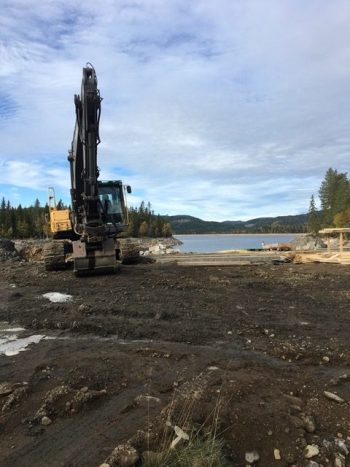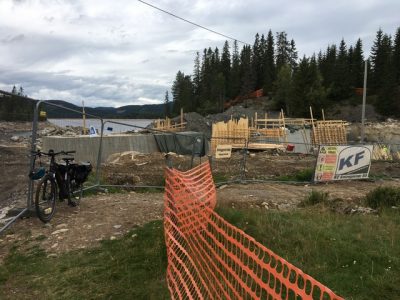Some welcome rain over Southern Norway in the past few days has reduced forest fire danger but water shortages loom, especially in Oslo. Not only was last month the driest April in 122 years, a combination of other factors have left the Norwegian capital vulnerable to a water crisis this summer.

Oslo residents received yet another warning from city officials on their mobile phones earlier this month, and were once again urged to take shorter showers, turn off the water while brushing teeth and avoid watering lawns. “Do that for Oslo,” read the text message, “so that we’ll still have water for the most important things in our lives.”
It simply didn’t snow very much in the Oslo area this past winter and there’s been hardly any rain this spring. May usually brings flood warnings because of snowmelt combined with April showers. This year, water levels in lakes and rivers are so low that there’s real danger for drinking water supplies.
Low water levels in dams in the mountains have already led to Norway’s highest electricity prices ever. The once-so-plentiful, clean and cold water that generated hydroelectric power and some of the best drinking water in the world has suddenly become a precious commodity. Forest fire danger warnings were in place for seven weeks, with water levels so low even in the country’s largest lake, Mjøsa, that its famed old paddlewheel vessel Skibladner hasn’t been able to sail. Local marinas that normally are home to lots of pleasure boats are high and dry.
Farmers were jubilant when rain finally fell in sufficient quantities late last week to help ward off a new drought. “It was enough to make things properly wet,” state meteorologist Rafael Escobar Løvdal told newspaper Aftenposten, “and everything will get greener, but the actual amounts (of precipitation) weren’t very large.”
It will also need to rain “a lot more and for a long time” in order to refill Oslo’s reservoirs. The water shortage in the capital is further compounded by other factors that have made the situation especially severe. Most all the city’s drinking water comes from lakes and dams in marka, the hills and forests that surround the city, and the majority of it flows into Maridalsvannet, a large lake on Oslo’s northern side.

One of the dams that sends water to Maridalsvannet, however, was in need of restoration work that began last summer. That meant that the large lake behind it, called Gjerdingen and located around 30 kilometers north of the city, actually had to be emptied last year so that the 109-year-old dam could be shored up.
Now it can look like a case of very bad timing, since Gjerdingen’s water has supplied around 15 percent of that in Maridalsvannet. The restoration work on the dam that brings it up modern standards is now being completed, but newspaper Aftenposten reports it will take around 18 months of “normal” precipitation to fill it up again, at a time when precipitation hasn’t been normal at all.
Most of the other roughly 28 small and mid-sized lakes and waterways in the hills above Oslo that feed into Maridalsvannet are also very low, leaving Maridalsvannet at just 66 percent of capacity as of late April. In a “normal” spring, it would be at 88 percent right now, hence all the warnings.
More water than Maridal’s needed
Meanwhile, Oslo is only now addressing the bigger and fundamental challenge for Oslo’s drinking water: that Maridalsvannet won’t supply enough in the future even with lots of precipitation. Oslo’s population has early doubled in the past 30 years and is expected to keep growing. The city finally launched a huge and expensive project to pipe water to Oslo from the Holsfjord between Drammen and Bærum. It won’t be completed for several more years.
Oslo is also suffering the immediate consequences of not only a dry spring, but a dry winter and autumn last year as well. Droughts have occurred before, but now the prospect is serious enough that officials are trying to make residents acutely aware of how important it is not to waste water. Current consumption levels amount to around 160 liters per person per day. Aftenposten reported that around 31 percent is used for personal hygiene, 23 percent for flushing toilets, 19 percent for laundry, 15 percent for washing dishes, 6 percent for food preparation and 6 percent for drinking and other use.
If water levels in Maridalsvannet sink below 59 percent, the city will halt all watering of lawns and flowers, washing streets and running fountains. Many of the latter haven’t been restarted yet after the winter.
City officials will then restrict car washing and watering of private lawns and gardens if water levels sink below 55 percent. If Maridalsvannet continues to decline, the city will reinstate water use from other lakes including Langlia and Alnsjøen. Since their water treatment facilities aren’t up to standard, however, Oslo residents will need to boil water before drinking it. As a last resort, Oslo will also use water from the popular recreational lake Nøklevann in the eastern forest of Østmarka, but that will also immediately halt all public use of the lake for swimming, fishing and even walking around it.
Officials at Oslo’s water and sewage department (Vann- og avløpsetaten, VAV) are disappointed that water conservation calls first issued last winter didn’t result in any significant reduction of water consumption. “We had hoped they would work,” Frode Hult, a divisional director at VAV, told Aftenposten, “but we sent out the first messages right near the end of the pandemic and just before a war in Europe, so we understand that they may have drowned in all the other news at the time.”
The warnings remain, he stresses, noting that if Oslo residents cooperate enough, no restrictions may be necessary. It’s mostly up to the weather at this point, though. If Oslo and the rest of Southern Norway have another dry summer and fall, the situation will become critical. Hult thinks restrictions will need to be imposed at some point during the next two years if the situation doesn’t improve.
newsinenglish.no/Nina Berglund

